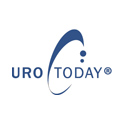TAIPEI, TAIWAN (UroToday.com) - Introduction and Objectives: Enhancing the ability to visually identify the ureter, and distinguish healthy versus nonviable ureter may facilitate robot- assisted ureteral reconstructions (RUR). Indocyanine green (ICG), a fluorescent dye that can be visualized under near- infrared light (NIRF), penetrates tissue and has a high signal-to-noise ratio. We describe our novel technique that utilizes intraureteral injection of ICG and subsequent visualization under NIRF to facilitate RUR and report our outcomes.
 Methods: RUR included ureterolysis (n = 4), pyeloplasty (n = 8), ureteroureterostomy (n = 9), and ureteroneocystostomy (n = 5). After full disclosure, all patients consented to off-label use of ICG. A ureteral catheter and/or percutaneous nephrostomy tube were used to inject 10 ml ICG into the diseased ureter, above and below the stricture. Intraoperatively, NIRF was activated to assist in identification of the ureter, and to localize the margins of ureteral strictures.
Methods: RUR included ureterolysis (n = 4), pyeloplasty (n = 8), ureteroureterostomy (n = 9), and ureteroneocystostomy (n = 5). After full disclosure, all patients consented to off-label use of ICG. A ureteral catheter and/or percutaneous nephrostomy tube were used to inject 10 ml ICG into the diseased ureter, above and below the stricture. Intraoperatively, NIRF was activated to assist in identification of the ureter, and to localize the margins of ureteral strictures.
Results: Our technique provided visual cues and aided in successful performance of 26 RUR in 25 patients. Mean age of patients was 52.1 – 17.9 years, BMI was 28.9 – 5.2 kg/m2, operative time was 166.8 – 69.2 min, EBL was 101.8 – 96.7 ml, and length of stay was 1.5 – 1.2 days. There were no intraoperative and postoperative complications attributable to ICG use. At a mean overall follow-up of 11.6 – 3.4 months, all procedures were clinically and radiologically successful.
Conclusions: Intraureteral injection of ICG and subsequent visualization under NIRF facilitates RUR by aiding in rapid and accurate identification of the ureter, and precise localization of the proximal and distal ureteral stricture margins. In our experience, our technique is safe, easy to perform, and reproducible.
Source of Funding: None
| Listen to an interview with Andrew Harbin, one of the authors of this study. |
Presented by Ziho Lee, Blake Moore, Laura Giusto, and Daniel Eun at the 32nd World Congress of Endourology & SWL - September 3 - 7, 2014 - Taipei, Taiwan
Temple University, Philadelphia, PA USA


